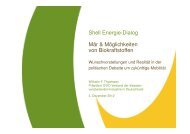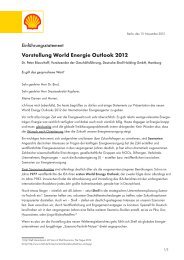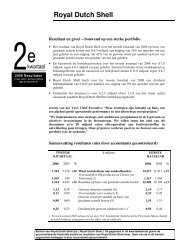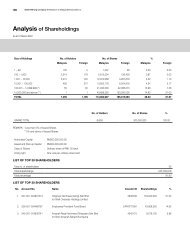62414 sustain 40pp (Mag)
62414 sustain 40pp (Mag)
62414 sustain 40pp (Mag)
Create successful ePaper yourself
Turn your PDF publications into a flip-book with our unique Google optimized e-Paper software.
RESPONSIBLE ENERGY<br />
Biodiversity<br />
Growing populations and rising wealth are putting many sensitive<br />
and biodiversity-rich ecosystems under threat. Meeting the world’s<br />
need for more and increasingly diverse energy supplies risks<br />
adding to the pressure. New technologies, partnerships and ways<br />
of working are needed. We are committed to helping and are<br />
making slow, but steady, progress in turning that commitment<br />
into action.<br />
As the 2005 Millennium Ecosystem Assessment made clear, governments<br />
urgently need to find the right balance between development and nature<br />
conservation. The biggest problem is encroachment by farming and<br />
housing. However, energy production also plays a role, from the search<br />
for oil and gas in sensitive areas, to the extra land needed for energy<br />
infrastructure and, increasingly, for energy crops.<br />
We were the first energy company to adopt a biodiversity standard.<br />
It requires us to respect protected sites, work with others to maintain<br />
ecosystems and seek partnerships to conserve biodiversity. We committed<br />
not to explore or develop for oil and natural gas in natural World<br />
Heritage Sites – more than 170 locations recognised by the United<br />
Nations Educational, Scientific and Cultural Organisation (UNESCO).<br />
We also committed to follow strict operating practices in places<br />
designated by the World Conservation Union (IUCN) as Category I–IV<br />
protected areas and in other areas of high biodiversity value. We are<br />
currently working on standards for sourcing biofuels for transport<br />
<strong>sustain</strong>ably (see box).<br />
Turning commitments into action<br />
Biodiversity checks are now included in the social and environmental<br />
impact assessments that are done at an early stage in our projects.<br />
Instructions for operating in areas of high biodiversity value are now<br />
included in our HSE Management System.<br />
18 THE SHELL SUSTAINABILITY REPORT 2006<br />
VOICES “ ”<br />
We also require operations in IUCN Category I–IV protected areas<br />
to have biodiversity action plans. These plans include measures to<br />
conserve or enhance local biodiversity and checks that these measures<br />
are implemented and effective. By early 2006, all these operations – in<br />
Brunei, the Netherlands, Nigeria (see box) and the USA – had plans in<br />
place. We aim to have similar plans in place for operations in other areas<br />
of high biodiversity value by the end of 2007.<br />
However, plans are only as good as our ability to execute them. Spreading<br />
awareness and skills of biodiversity management to key project staff<br />
remains a priority. Our library of case studies, which was updated and<br />
expanded in 2006, is helping us do this. So is the biodiversity network,<br />
which shares examples of good practice between project teams. We are<br />
also developing training programmes on implementing biodiversity<br />
action plans.<br />
Working with others<br />
To support global biodiversity conservation and reduce biodiversity<br />
impacts around our operations, we work with (and learn from) more<br />
than 100 scientific and conservation organisations in 40 countries.<br />
Details of our work with some of these organisations is available on<br />
the web.<br />
Additional web content:<br />
• Our approach to biodiversity in practice (case studies).<br />
• Our work with others to promote conservation.<br />
• Protecting biodiversity at operations in IUCN protected areas.<br />
www.shell.com/biodiversity<br />
BIODIVERSITY ACTION PLAN: NIGERIAN INDIGENOUS FORESTS<br />
In the Niger Delta, we have concessions to extract oil and gas in<br />
two indigenous forest reserves that are IUCN protected areas.<br />
We have not produced in these areas for many years, but have<br />
dormant oil wells in one and active pipelines across the other.<br />
The paths we built when we were producing here may have also<br />
provided access to these areas for others and made illegal<br />
logging and hunting possible.<br />
In 2005, the SPDC joint venture launched two biodiversity action<br />
plans to preserve the forest and develop alternative sources of<br />
income for the local community.<br />
The plan was drawn up with farmers, local groups and the<br />
[Editor: state] government. Actions include programmes to raise<br />
awareness of biodiversity in the local community, and projects to<br />
develop alternative sources of revenue from the forests. Under the<br />
plan, control over logging has been moved from the government<br />
to a community forest management committee. We will fund their<br />
delivery. The forest-based communities own the plans and are<br />
responsible for implementing them.<br />
Jonathan Amakiri<br />
PRINCIPAL ENVIRONMENTAL ADVISOR, SHELL NIGERIA





![Download Shell AutoGas Stationen [Stand: Januar 2013] (PDF](https://img.yumpu.com/9982753/1/190x245/download-shell-autogas-stationen-stand-januar-2013-pdf.jpg?quality=85)











